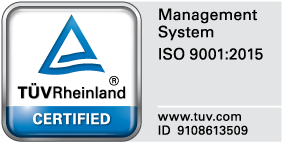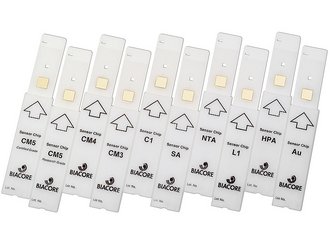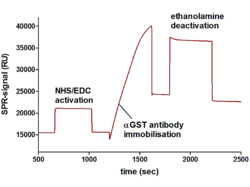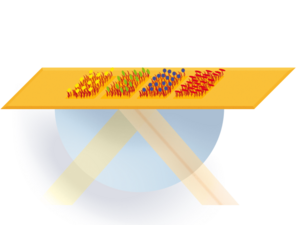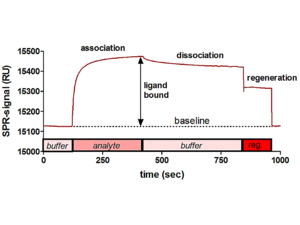Biacore Technology
The gold standard in biomolecular interaction analysis (BIA) using surface plasmon resonance (SPR)
BIACORE SPR BIOSENSORS
A Biacore system consists out of a light source emitting near infrared light, a sensor chip, an automated liquid handling system with constant flow and a diode array position-sensitive detector. One of the two interacting partners (referred to as the ligand) is immobilised on the sensor surface. The other binding partner, called the analyte, is directed over the surface in a constant flow system allowing to monitor the interaction of binding partners in real time. Depending on the molecular mass of the analyte, Biaffin uses different Biacore systems to guarantee best performance with highest sensitivity for your target molecule!
SENSOR CHIP
The sensor chip consists of a small glass plate covered with a thin gold layer. The biospecific matrix consisting of carboxymethylated dextrane is coupled onto this gold layer providing a hydrophilic environment with low unspecific binding. These functionalised surfaces enable chemical coupling of ligands or capturing molecules via native amine, sulfhydryl, aldehyde or carboxyl groups. A number of different sensor chips with various features are available allowing a flexible experimental design.
IMMOBILISATION
Ligand coupling
Coupling of a ligand can be achieved either covalently (non-reversible) or non covalently (reversible) using capturing molecules (i.e. antibodies), which bind the ligand with high affinity. The most commonly used method to covalently couple biomolecules in BIA is amine coupling. Here primary amines, for example from the amino acid lysine, are functionalised using standard chemistry. Other functional groups commonly used are thiols or aldehydes. Antibodies can be employed as capturing molecules binding highly specific to the ligand and allowing to regenerate a surface by disrupting the antibody-ligand binding after the interaction with the analyte.
Immobilisation of an anti-GST antibody via amine coupling
The functionalised dextran surface is activated and the GST antibody is immobilised. Then the surface is deactivated removing all unspecifically bound antibody. The amount of immobilised antibody can be calculated from the difference between the baseline before the immobilisation and after deactivation of the surface in Response Units [RU].
Covalent coupling using cysteines
Surface thiol method
The surface thiol procedure uses thiol groups on the sensor surface exchanging with a reactive disulphide group introduced into carboxyl or amino groups of the ligand. This method can be used for ligands that do not contain intrinsic thiol groups (i.e. no cysteines) and allows coupling of different functional groups of the ligand
Ligand thiol method
The ligand thiol procedure uses intrinsic thiol groups in the ligand, i.e. cysteines, which are exchanged with a reactive disulphide group on the sensor surface.
DETECTION SYSTEM
Interaction Analysis: Monitoring association and dissociation in real time
Biomolecular binding events cause changes in the refractive index at the surface layer, which are detected as changes in the surface plasmon resonance (SPR) signal. In general, the refractive index change for a given change of mass concentration at the surface layer is practically the same for all proteins and peptides and is similar for glycoproteins, lipids and nucleic acids. This value is plotted as Resonance Units (RU).
A typical sensorgram demonstrates the real time monitoring of binding events.
The figure shows the interaction of an analyte in solution with its respective ligand immobilised on the sensor surface. Dissociation was initiated by switching to running buffer. Since the dissociation rate is slow the surface has to be regenerated with an appropriate elution buffer disrupting the complex. In this case the regeneration is complete and does not affect the binding activity of the immobilised ligand.
Tel.: +49 (0) 561-804 4661 | Fax: +49 (0) 561-804 4665 | info@biaffin.de
We value your privacy
In order to optimize our website for you and to be able to continuously improve it, we use cookies. Further information is available in our Data Protection Statement. Here you can find our Legal Information.





